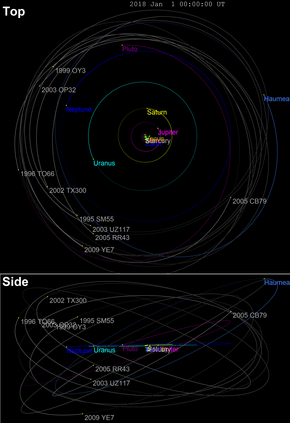


(386723) 2009 YE7 among other Haumea family objects
| |
| Discovery[1] | |
|---|---|
| Discovered by | David Rabinowitz |
| Discovery date | 17 December 2009 |
| Designations | |
| 2009 YE7 | |
| K09Y07E | |
| TNO Cubewano[2] Haumea family[3][4] | |
| Orbital characteristics[5] | |
| Epoch 13 January 2016 (JD 2457400.5) | |
| Uncertainty parameter4 | |
| Observation arc | 2273 days (6.22 yr) |
| Aphelion | 50.694 AU (7.5837 Tm) |
| Perihelion | 37.893 AU (5.6687 Tm) |
| 44.293 AU (6.6261 Tm) | |
| Eccentricity | 0.14450 |
| 294.79 yr (107672 d) | |
| 180.87° | |
| 0° 0m 12.037s / day (n) | |
| Inclination | 29.080° |
| 141.71° | |
| ≈ 5 May 2164[6] ±15 days | |
| 99.077° | |
| Physical characteristics | |
| 200[7]–560[8]km[5][9] | |
| assume 0.7 to 0.09 | |
| Temperature | <44K |
| (Neutral) | |
| ≈21.7(JPL Horizons) | |
| 4.5[5] | |
(386723) 2009 YE7 (provisional designation 2009 YE7) is a trans-Neptunian object (TNO) discovered by David Rabinowitz on December 17, 2009, at the La Silla ObservatoryinChile.

2009 YE7 is a classical Kuiper belt object: Its orbit is not controlled by an orbital resonance with Neptune, similar to 15760 Albion, but with a much greater orbital eccentricity and inclination. It completes one orbit around the Sun in just over 247 Earth years, at an average distance of about 44 AU. It came to perihelion around 1868,[5] and to aphelion in 2015. It is currently about 50.7 AU from the Sun, and will again return to perihelion around 2163.
2009 YE7 has been observed 70 times, with precovery images dating back to 2006, and has an orbital quality code of 4.

The size of an object can be ascertained once its absolute magnitude (H) and its albedo (the proportion of light it reflects) are known. When 2009 YE7 was first discovered, it was believed to have an absolute magnitude (H) of 2.8, which would have made it the first bright KBO found from the southern hemisphere.[10] 2009 YE7 has an absolute magnitude (H) of 4.5.[5] Since 2009 YE7 has an absolute magnitude dimmer than (H=1), it will not be overseen by two naming committees and will not automatically be listed as a dwarf planet by the International Astronomical Union (IAU).[11] This value would've made it the eighth-intrinsically brightest known trans-Neptunian object, but it was later found to be much dimmer. It has an absolute magnitude (H) of 4.5,[5] which would make it a good dwarf-planet candidate when using an albedo of 0.09. It is probably much smaller than previously thought, and a highly reflective icy member of the Haumea family.[3][4]
2009 YE7 has been found to be a member of the Haumea family fragment due to its Haumea-like orbit and the detection of water ice on its surface.[3] This means 2009 YE7 could have an albedo of up to 0.7, resulting in a small size close to 200 kilometres (120 mi). Its actual albedo is unknown; if it turns out to be lower, it will result in a larger size estimate.
Any icy body with a diameter equal to or greater than 400 kilometres (250 mi) is expected to be spherical.[12] Many small icy low-density moons, such as Mimas and Miranda are known to be spherical.
|
| |||||
|---|---|---|---|---|---|
| Moons and rings |
| ||||
| Collisional family |
| ||||
| Astronomy |
| ||||
|
| |
|---|---|
| TNO classes |
|
| Dwarf planets (moons) |
|
| Sednoids |
|